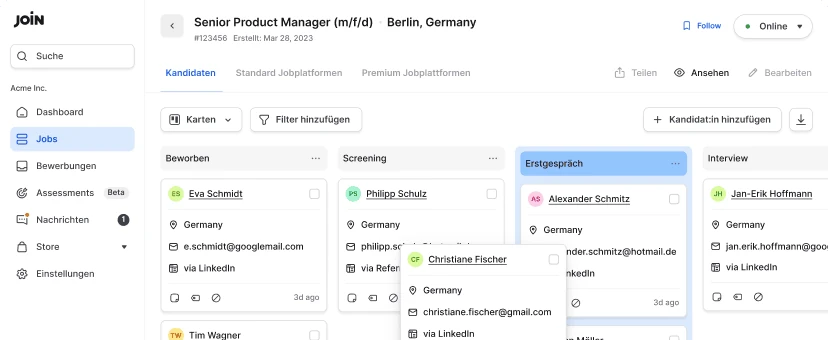How to hire an employee in 10 clear steps
Hiring an employee means much more than just adding a member to your team. It’s a significant step that holds the potential to shape the future trajectory of a company.
And that’s especially true if you’re about to hire your first employee (or one of your first). Because if you’re running a startup or small business, any new hire will have a tremendous impact on your team.
But regardless of your company’s size, hiring the right individuals will help grow and strengthen your organisation. And that’s why it’s so important to create a smooth and structured hiring process that helps you more easily find and hire employees.
Now, the many steps and decisions you have to make when creating your recruiting process can feel overwhelming for those new to the journey. But not to worry.
Below, you’ll find an easy-to-digest overview of how to hire an employee. You’ll learn about hiring practices that help you find and attract the best candidates.
Here’s a peak at what’s included:
Table of contents
10 steps to hiring an employee for your business
Every company will have a slightly different hiring process. Some have a dedicated HR team, while others solely work with hiring managers depending on the job opening.
Nevertheless, certain steps in the process will apply to companies of all shapes and sizes. These tried-and-tested methods will help you hire a team more quickly and efficiently. So learn how to hire someone in 10 steps!
1. Understand your business needs
The first step in the hiring process is identifying the need for a new employee. This involves assessing the current workforce and determining if there are any skill gaps or staffing needs that need to be addressed.
By clearly defining the requirements and responsibilities of the position, employers can effectively communicate their expectations to potential candidates.
During this stage, it is important to consider the company’s long-term goals and how the new hire will contribute to its success. This involves evaluating team dynamics, workload, and future growth plans.
By taking a strategic approach to identifying the need for a new employee, employers can ensure that the hiring decision aligns with the overall business strategy.
2. Prepare the legalities
To hire an employee, you need to ensure you have all the necessary legal requirements in place. What the exact requirements are for your company will depend on the country you’re based in.
Unless you have a legal background, you’re likely best off consulting an attorney to determine what needs to be in place before hiring employees.
3. Craft a compelling job description
Now the stage is set and the groundwork has been done, it’s time to actually start working on looking for those job candidates. And that starts with writing a job description for your job ad.
A well-crafted job description is essential to attract the right talent. It should provide a glimpse into your company culture, outline the responsibilities and expectations of the role, and highlight the required skills and qualifications.
Incorporate your company values, such as diversity and inclusion, to demonstrate your commitment to creating an inclusive work environment.
Keep the job description concise, clear, and focused. Avoid using language or requirements that (unintentionally) exclude candidates or violate equal employment opportunity laws. Strive for inclusivity and diversity in your job descriptions to attract a wide range of qualified candidates.
4. Develop a recruitment strategy
Deciding on the right recruitment strategy is crucial to reach potential candidates effectively. Consider the size of your company and the resources at your disposal. Recruitment and talent acquisition are two common approaches.
Check out: Talent acquisition vs. recruitment
Recruitment focuses on fulfilling immediate hiring needs, often through job ads, recruitment events, and employee referrals. Talent acquisition, on the other hand, takes a more long-term approach, building talent pipelines and nurturing relationships with potential candidates.
Determine which approach aligns best with your goals and resources. For small business owners or a startup looking for its first hire, the choice tends to favour recruitment rather than talent acquisition first.
5. Advertise in the right places
Once you’ve crafted a compelling job description, it’s time to get the word out that you’re hiring employees. Consider posting job ads on your company career page (find out how to create your own career site), leveraging your social media platforms, and using online job boards.
For many company owners and hiring managers, posting ads to job sites is the best way to hire employees. While popular job boards like LinkedIn and Indeed can reach a broad audience, consider niche job boards that cater to specific communities or industries to better target the right person for the job. It also helps ensure diversity and inclusivity in your talent pool.
To post a job ad to a job board, you start by simply creating an account on your board of choice. For example, we explain how to create a LinkedIn Business page in this article. Next, you upload all the necessary information for the job posting (like job title and job requirements) before publishing the ad. If you want, you can pay for premium placements to speed up the talent attraction process.
Check out: How to post a job on LinkedIn
You can do the same thing for all job sites of interest. Or, you can use dedicated job distribution software (like JOIN) that allows you to publish your ad to hundreds of job sites at once. You simply create an account and upload your job ad, after which you can select the relevant job boards and post your job postings to them with just one click.
6. Review applications and shortlist candidates
As applications start pouring in, it’s time to review them and shortlist the most promising candidates. Develop a systematic approach to compare qualifications, experience, and skills with the job description. Be mindful of potential biases and when screening applicants, avoid screening out candidates based on arbitrary criteria.
Leverage an applicant tracking system (ATS) to streamline the process and manage applications efficiently. Some handy features offered by many such software solutions include automated resume parsing and customisable job application forms with pre-screening questions.
Check out: 5 best recruiting software for small businesses in 2024
7. Conduct effective interviews
The interview process is a crucial part of the hiring process, providing an opportunity to assess candidates’ suitability for the role.
Prepare a structured interview format with a set of standardised interview questions to ensure consistency and fairness. This approach allows each candidate an equal chance to showcase their skills and experience. Using an interview scorecard can help ensure you judge candidates based on the same criteria.
During the interview, probe beyond technical qualifications and assess cultural fit and soft skills. Ask questions that reveal a candidate’s problem-solving abilities, long-term goals, strengths, and weaknesses.
Remember to comply with equal employment opportunity laws and avoid questions that may elicit information about a candidate’s protected characteristics.
8. Extend the job offer
Once you’ve identified the perfect candidate, it’s time to extend a job offer. Formalise the offer by sending a written letter (or email it as a PDF document) outlining employment terms and conditions.
Be prepared for negotiations, as candidates may seek to discuss salary and employee benefits. Consider the market rate for similar roles and be open to finding a mutually beneficial agreement.
Even if a candidate declines the offer, maintain a positive and professional relationship. They may be a great fit for future opportunities and present the ideal candidate the next time you’re hiring employees for a role.
9. Onboard and welcome your new employee
Congratulations! You’ve successfully hired an employee. As you came here wondering how do I hire an employee, you might assume the process is now over. But not quite yet.
Now, it’s time to onboard and welcome them to your team. Create an onboarding process that ensures a smooth transition and sets the new employee up for success.
Gather all necessary paperwork, such as tax forms and employment contracts. Introduce the new employee to their team members and provide them with the necessary tools and resources to perform their job effectively.
Consider assigning a mentor or buddy to help them navigate the company culture and foster a sense of belonging.
10. Maintain employee records
As an employer, it’s important to maintain accurate and organised employee records.
Create a digital personnel file for each employee, including relevant documents such as resumes, job descriptions, offer letters, and any correspondence. Store these files securely to ensure confidentiality and easy access when needed.
Consider using an HR software system to streamline and automate record-keeping processes. These tools can help you stay organised, ensure compliance with data protection regulations, and simplify employee information management.

The importance of a well-structured hiring process
A well-structured hiring process is essential for several reasons. First and foremost, it helps streamline the recruitment process and ensure that all necessary steps are followed. This not only saves time and resources, but also increases the chances of finding the best candidate for the job.
Additionally, having a structured process ensures consistency and fairness in evaluating potential new hires, which is crucial for avoiding bias and making informed decisions.
By following a standardised process, employers can objectively compare candidates based on their qualifications, skills, and experience rather than relying on personal preferences or subjective judgments.
Furthermore, a well-structured hiring process helps to create a positive employer brand and leaves a lasting impression on candidates.
When job seekers have a positive experience during the hiring process, they are more likely to view the company as a desirable place to work. This can attract top talent and enhance the company’s reputation in the market.
How to hire the best employees
Hiring the right employees is essential for the growth and success of your business. By following these steps and implementing best practices, you can simplify the hiring process and find the right fit for your company.
But to truly find and hire the best talent out there, the hiring process is just one of many HR and recruitment processes that you need to perfect. Luckily, here at JOIN, we have hundreds of valuable free resources to help you become a recruitment pro (like the Recruitment & HR Blog you’re visiting right now!)
We’ve helped over 100,000 companies, from small business owners to enterprises like Sony and Lufthansa, hire the best employees for their organisation. Try it out for yourself and see how we can help:
Frans Lelivelt
Frans is JOIN's multilingual Senior Content Manager. His main topic of interest in the recruitment space is DEI and how companies can reduce their (unconscious) biases to make the world of work a fairer, kinder place for everyone. Outside of work, he tries to do the same for animals, spending much of his spare time in the kitchen preparing plant-based feasts.




